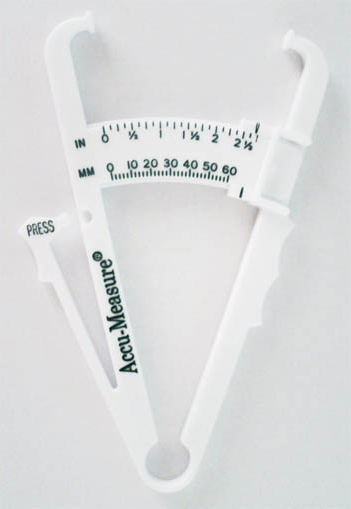Methods of Measuring Body Fat Percentage

Accurately assessing body fat is important
When approaching weight loss, body fat percentage is far more important than absolute weight because it provides a more accurate assessment of a person's overall health and fitness level.
Two people of the same height and weight can have vastly different body compositions, with one person carrying more muscle mass and less body fat, and the other carrying more body fat and less muscle mass.
Carrying too much body fat, especially in the abdominal area, is associated with a higher risk of many health conditions, including heart disease, diabetes, high blood pressure, and certain cancers.
In contrast, having a higher proportion of muscle mass and less body fat can improve metabolic health and physical performance.
Measuring body fat percentage can also be a better indicator of weight loss progress than absolute weight. Losing weight doesn't necessarily mean that a person is losing body fat, as weight loss can come from a combination of fat, muscle, and water loss. However, tracking body fat percentage can provide a more accurate assessment of changes in body composition over time.
A Practical, Affordable and Positive Weight Loss Camp Experience
- All-Inclusive Rates
- Comfortable Accommodations at The Courtyard by Marriott
- Deliciously Prepared Meals
- Expert Guidance
- Amazing Results
Expert fitness guidance, wholesome meals, a refreshing Florida setting, and a structured, supportive environment will help you change the course of your overall health and wellness.
Take some time to invest in yourself.
Methods of Measuring Body Fat
Body Mass Index
Body mass index (BMI): BMI is a measure of body fat based on a person's weight and height. This is the most commonly used metric, as it is extremely easy to calculate.
Body mass Index is calculated by dividing a person's weight in kilograms by the square of their height in meters. The formula for calculating BMI is as follows:
For example, a person who weighs 70 kilograms and is 1.75 meters tall would have a BMI of:
BMI = 70 / (1.75 x 1.75) = 22.9
BMI is often used as a screening tool for weight categories that may lead to health problems, such as overweight or obesity. BMI is not always an accurate measure of body fat however, as it does not take into account factors such as muscle mass and bone density.
Body fat percentage may be estimated from BMI via these equations - where sex is 0 for female or 1 for male:
This conversion metric is only as accurate as the BMI result itself. A highly muscular person for example, may have a high BMI but a low body fat percentage, while an older person may have a low BMI but a higher body fat percentage.
Body Adiposity Index
Body adiposity index (BAI) is a measure of body fat percentage based on a person's hip circumference and height. Sometimes referred to as waist circumference measurement, BAI was developed as an alternative to body mass index (BMI), which is a widely used measure of body fat based on weight and height.
BAI is calculated by dividing hip circumference (in centimeters) by height (in meters) raised to the power of 1.5, then subtracting 18. The resulting number is an estimate of body fat percentage, with higher numbers indicating higher levels of body fat.
BAI has been suggested as a potentially more accurate measure of body fat than BMI, particularly for individuals who are muscular or have a larger body frame. However, research on the validity of BAI as a measure of body fat has been mixed, with some studies suggesting that it may not be as accurate as other methods, such as dual-energy x-ray absorptiometry (DEXA) or bioelectrical impedance analysis (BIA).
While the U.S. Army and U.S. Marine Corps rely on the height and circumference method of measurement, BAI is not yet widely used as a measure of body fat percentage in clinical practice.
Hydrostatic Weighing
Hydrostatic weighing, also known as underwater weighing, is a method of determining body fat percentage by measuring a person's body density. It is based on the principle that fat tissue has a lower density than lean body tissue, such as muscle and bone.
To perform hydrostatic weighing, a person is submerged in water and their weight is measured. The person then exhales all the air from their lungs and is completely submerged in water again, while a technician measures the volume of water that is displaced by the person's body. From these measurements, the person's body density can be calculated using a standard equation.
Once the body density is known, the person's body fat percentage can be estimated using another equation that takes into account their age, gender, and other factors. This equation assumes that fat tissue has a density of 0.9 grams per milliliter, while lean body tissue has a density of 1.1 grams per milliliter.
Hydrostatic weighing is considered one of the most accurate methods for measuring body fat percentage, with an error rate of around 2-3%. However, it can be expensive and time-consuming, and requires specialized equipment and trained technicians. It may also not be suitable for people who are uncomfortable with being submerged in water or who have certain medical conditions.
Full-body Air Displacement Plethysmography
Air displacement plethysmography, also known as Bod Pod, is a method of estimating body fat percentage by measuring a person's body volume and body weight. It is based on the principle that fat tissue and lean body tissue have different densities, and therefore different volumes for the same weight.
To perform air displacement plethysmography, a person sits inside a small chamber that measures the amount of air displaced by their body. The person wears minimal clothing or a form-fitting suit to reduce the amount of air trapped in their clothing. The measurement takes only a few minutes and does not require the person to be submerged in water or in direct contact with any equipment.
From the measurement of body volume and body weight, a computer program calculates the person's body density. Using the same equations as with hydrostatic weighing, the person's body fat percentage can then be estimated based on their body density, age, gender, and other factors.
Air displacement plethysmography is considered a highly accurate method for measuring body fat percentage, with an error rate of around 1-2%. It is also non-invasive and easy to perform, making it a popular alternative to hydrostatic weighing for people who are uncomfortable with water submersion or who have certain medical conditions. However, like hydrostatic weighing it can be prohibitively expensive and is rarely available in fitness or medical centers.
Dual Energy X-ray Absorptiometry
Dual energy X-ray absorptiometry (DXA) is a medical imaging technique that is used to measure bone density and body composition, including body fat percentage. It works by passing two low-dose X-ray beams of differing energy levels through the body, which are absorbed differently by bone, lean tissue, and fat tissue.
To perform DXA, a person lies on a table and a scanner arm moves over their body, typically taking about 10-20 minutes to complete. The person is exposed to a very low dose of radiation, which is considered safe for most people.
The DXA scan produces an image of the body, which can be used to measure bone mineral density as well as lean tissue and fat tissue distribution. The software used with the DXA scan can estimate the total amount of fat and lean tissue in the body, and calculate body fat percentage based on these measurements.
DXA is considered a highly accurate method for measuring body composition and body fat percentage, with an error rate of around 1-2%. It can also provide additional information about bone density and skeletal health, making it a useful tool for assessing overall health and fitness. However, DXA scans are relatively expensive and require specialized equipment and trained technicians, so they may not be readily available in all settings.
Near-Infrared Interactance
Near-infrared interactance (NIR) is a non-invasive method of estimating body fat percentage that uses near-infrared light to measure the amount of fat tissue in the body. The technique is based on the principle that different types of tissue absorb and reflect light differently, and near-infrared light is absorbed more strongly by fat tissue than by lean tissue.
To perform NIR, a small hand-held device is placed on the skin at various points on the body, typically the biceps, triceps, and subscapular regions. The device emits a low-intensity beam of near-infrared light into the skin, which is reflected back to the device and analyzed by a computer program. The amount of light that is absorbed by the tissue can be used to estimate the amount of fat tissue in the body.
NIR is considered a relatively simple and non-invasive method for estimating body fat percentage, with minimal risk to the person being tested. It is also relatively inexpensive and does not require any specialized equipment or trained technicians. However, it may not be as accurate as other methods, with an error rate of around 3-4%, and the measurements can be affected by factors such as skin color, hydration, and temperature.
Bioelectrical Impedance Analysis
Bioelectrical impedance analysis (BIA) is a non-invasive method for estimating body fat percentage by measuring the resistance of the body to a small electrical current. This method is based on the principle that different types of tissue, such as fat and lean tissue, conduct electricity differently.
To perform BIA, electrodes are attached to the skin on the hands and feet, and a small electrical current is passed through the body. The resistance of the body to the electrical current is measured, and this measurement is used to estimate the amount of lean tissue and fat tissue in the body.
BIA is considered a quick and convenient method for estimating body fat percentage, with minimal discomfort for the person being tested. It is also relatively inexpensive and widely available, with handheld devices that can be used at home or in a clinical setting. However, the accuracy of BIA can be affected by factors such as hydration status, body temperature, and the type of electrode used.
Skinfold Estimation (Calipers)
Skinfold estimation methods are a set of techniques used to estimate body fat percentage by measuring the thickness of skinfolds at various points on the body. These methods are based on the principle that subcutaneous fat, which is the fat located just beneath the skin, is distributed in proportion to total body fat.
To perform skinfold estimation, a trained technician uses calipers to measure the thickness of skinfolds at several different sites on the body, such as the triceps, biceps, subscapular, and suprailiac regions. The measurements are then entered into a formula, such as the Jackson-Pollock or Durnin-Womersley equations, to estimate body fat percentage.
Skinfold estimation methods are relatively inexpensive and non-invasive, making them a popular choice for routine body fat measurements. However, the accuracy of the method is highly dependent on the skill and experience of the technician performing the measurement, as well as the location of the skinfold sites measured.
Ultrasound Measurement
Ultrasound can be used to estimate body fat percentage by measuring the thickness of subcutaneous fat layers at various points on the body. This method is based on the principle that ultrasound waves can penetrate the skin and reflect back to the transducer, allowing the thickness of the fat layer to be measured.
To perform ultrasound body fat measurements, a trained technician places a small handheld device called an ultrasound transducer against the skin and moves it over the area of interest. The device emits high-frequency sound waves that penetrate the skin and reflect back to the transducer, creating an image of the underlying fat layer.
The thickness of the fat layer can be measured from the ultrasound image, and these measurements can be used to estimate body fat percentage. Ultrasound measurements can be taken at multiple sites on the body, such as the biceps, triceps, subscapular, and suprailiac regions, and these measurements can be used in combination with other body fat measurement techniques to improve accuracy.
Ultrasound is a non-invasive and safe method for measuring body fat percentage, and it can provide a somewhat more accurate measurement of subcutaneous fat thickness than skinfold measurements - depending on the skill and experience of the technician performing the measurement, the type of equipment used, and the location of the measurement site.







